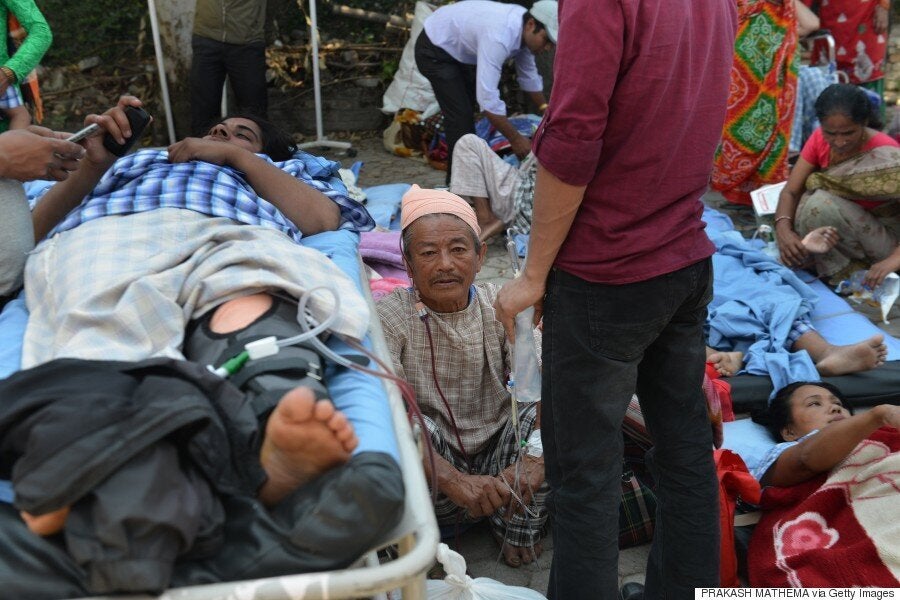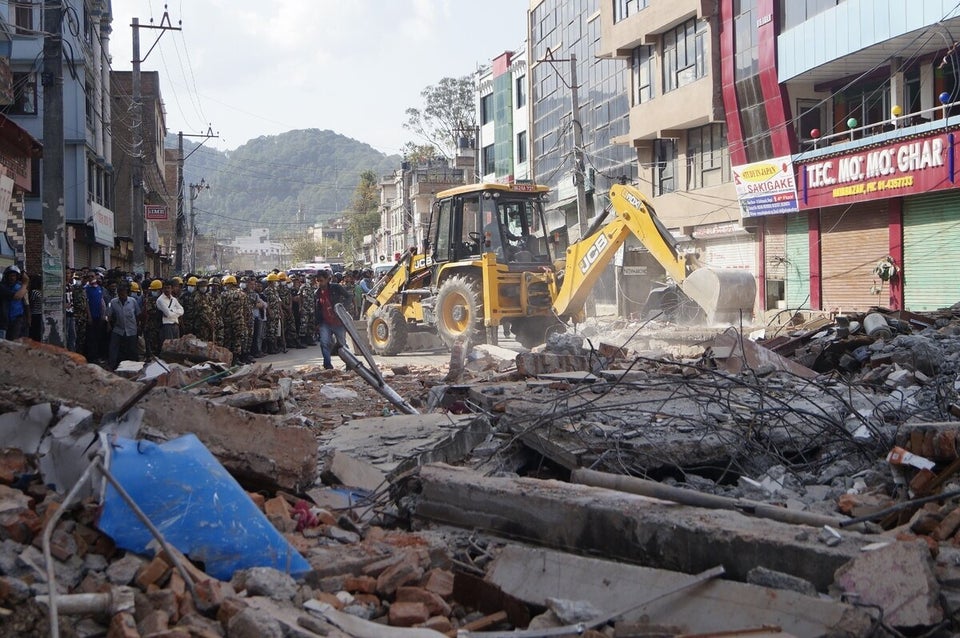A earthquake of 7.3 magnitude has struck Nepal, just two weeks after a devastating quake killed at least 8,000 people in the country.
The US Geological Survey initially said the quake was 7.1 in magnitude, but then swiftly upgraded it to 7.3.
Tuesday's disaster hit near the Chinese border between the capital of Kathmandu and Mount Everest, with at least 42 people now confirmed dead according to local Indian media.
Devastation was reported in the Katmandu, which is still reeling after buildings were flattened and sacred sites destroyed after the 7.8 earthquake of 25 April that wiped out whole villages nearby.

Injured people lie on stretchers after the quake
Buzzfeed's deputy news director Jon Passantino said there were "multiple landslides, building collapses and bodies being pulled out after latest Nepal quake."
"Shopkeepers closed their shops and the streets were jammed with people rushing to check on their families," tweeted Reuters journalist Tony Tharakan. "Parents could be seen clutching children tightly and hundreds of people were frantically trying to call relatives on their mobile phones."
The quake was followed closely by at least five aftershocks measuring from magnitude 5.6 to magnitude 6.3.
Jack Board, at Katmandu airport, tweeted: "The walls inside the international terminal at Kathmandu airport started to crumble. I can [see] big plumes of dust looking back over the city."
The international airport, which has become a transport hub for international aid, was closed temporarily, while the streets were blocked with traffic in the chaos.
A Save The Children UK operations base - being used to help people affected by the first quake - was also damaged.
A Twitter account for Nepal Police advised people to stay in the open away from buildings, and to use text messages rather than voice calls to try to reach loved ones. It tweeted: "Please stay in open field, help us make free road, do not make phone nw busy. SMS is suggested."
An official with an International Organisation for Migration said a number of buildings collapsed in the isolated town of Chautara, and a rescue team had already begun searching through the wreckage of the little town.
Chautara has become a hub for humanitarian aid in the wake of the April 25 quake, with dozens of aid workers now based there to send help deeper into the countryside.
According to Bloomberg, tremors were felt as far away at India's capital, New Delhi.
Tuesday's quake was deeper than the first, coming from a depth of 11.5 miles versus the 25 April quake that hit 9.3 miles below the surface. More shallow earthquakes tend to cause more damage at the surface.
"The shaking seemed to go on and on," said Rose Foley, a UNICEF official based in Katmandu. "It felt like being on a boat in rough seas."
Aid agencies were still struggling Tuesday afternoon to get reports from outside of the capital.
"We're thinking about children across the country, and who are already suffering. This could make them even more vulnerable," Foley said.
The quake sent people rushing outside of their homes in katmandu. Police gave no immediate estimates of damage.
Indian Embassy spokesman Abhay Kumar said some buildings in Katmandu collapsed, but he gave no further details about how many or where they were. Experts say the April 25 quake caused extensive structural damage even in buildings that did not topple, and that many could be in danger of future collapse.
Rasmus Baastrup, a Dane from Doctors Without Borders, said in a live interview with Denmark's TV2 channel "I walked out quickly. I couldn't run because the earth was shaking so much that it was impossible to run." Baastrup, speaking from Kathmandu, said he had been told that all staff with Doctors Without Borders were alive but was not more specific.
Norway's Red Cross, which was helping people from the 25 April earthquake at a 60-bed hospital in Chautara in central Nepal, said on Twitter in Norwegian that there were "many injured, several killed" and added that their hospital tents already has gotten patients.
"People are terribly scared. Everyone ran out in the streets because they are afraid of being inside the houses," Norwegian Red Cross Secretary-General Asne Havnelid told Norwegian broadcaster NRK.
At the Norvic Hospital in Kathmandu, patients and doctors rushed to the parking lot.
"I thought I was going to die this time," said Sulav Singh, who rushed with his daughter into the street in the suburban neighborhood of Thapathali. "Things were just getting back to normal, and we get this one."
Nepalese have been terrified by dozens of aftershocks that hit the country in the days following the 25 April quake. Meanwhile, the impoverished country has appealed for billions of dollars in aid from foreign nations, as well as medical experts to treat the wounded and helicopters to ferry food and temporary shelters to hundreds of thousands left homeless amid unseasonal rains and unreachable with landslides blocking many mountain roads.
"This was a jolt just like the big one last month, though it was not that long," said Kathmandu resident Avinav Shrestha. "I was very scared, though. Anything can happen."
Strong shaking was also felt across northern India. In the Indian capital of New Delhi, people scrambled outdoors while buildings swayed.
Across the Nepalese border in Tibet's Jilong and Zhangmu regions, the Earth shook strongly. Tremors were also felt slightly in the Tibetan capital, Lhasa.
"Rocks fell from the mountains," Jilong county government vice chief Wang Wenxiang was quoted as saying by China News Service. "There might be some houses collapsed or damaged. We are now checking on the condition of the people."
The new quake struck near the town of Namche Bazar, near the base camp of Everest, where hundreds of climbers were trapped after the first earthquake, when avalanches that killed at least 19 people. It was the deadliest day for climbing on record at the popular landmark.
The epicentre of the latest earthquake was 52 miles east of Kathmandu, in a rural area close to the Chinese border, The BBC reported.
SEE ALSO
- Pictures Show How Nepalese Villagers Are Surviving After Quake
- These Beautiful Pictures Are Helping Support The Nepal Earthquake Relief Efforts
- Want To Help With The Nepal Relief Efforts? Here's How
- Incredible Video Captures Terrifying Moment Avalanche Hit Everest
- Nepal's Race Against Time as the Monsoon Season Approaches
- How We Can Protect Children in Nepal
One incredible video from the first quake captured the moment an avalanche hit the mountain, where German climber Jost Kobusch survived when climbers were cut off from the base camp.
[Warning: Video contains strong language]
Nepal is still in mourning for the 25 April earthquake, in which at least 18,000 people were injured, while relief efforts continue to help those who have lost their homes and livelihoods.
